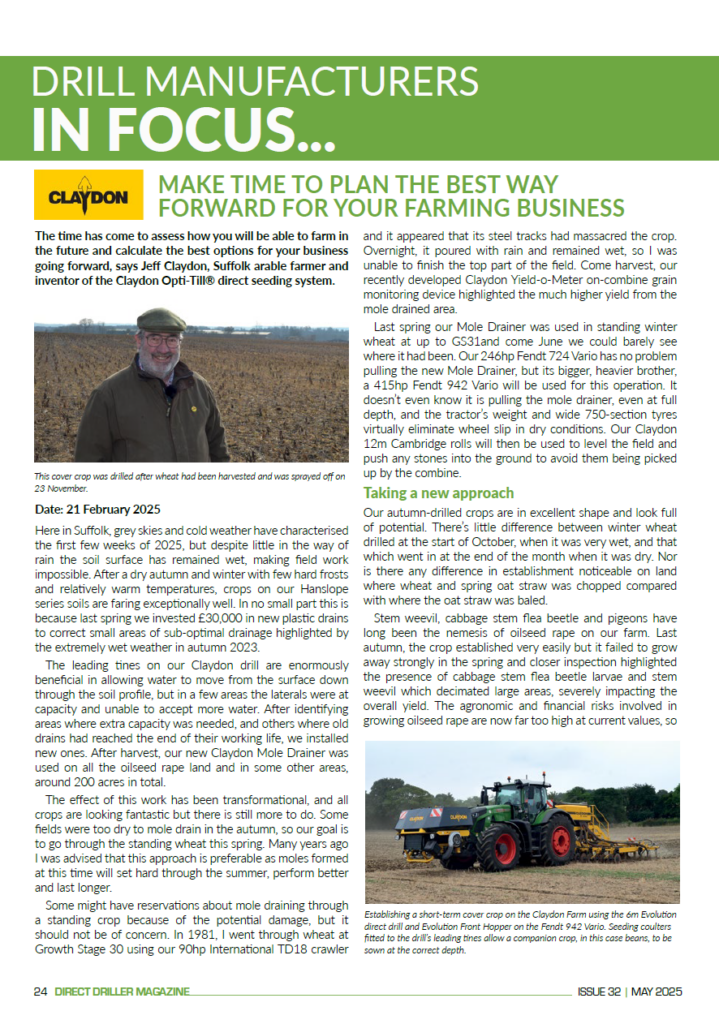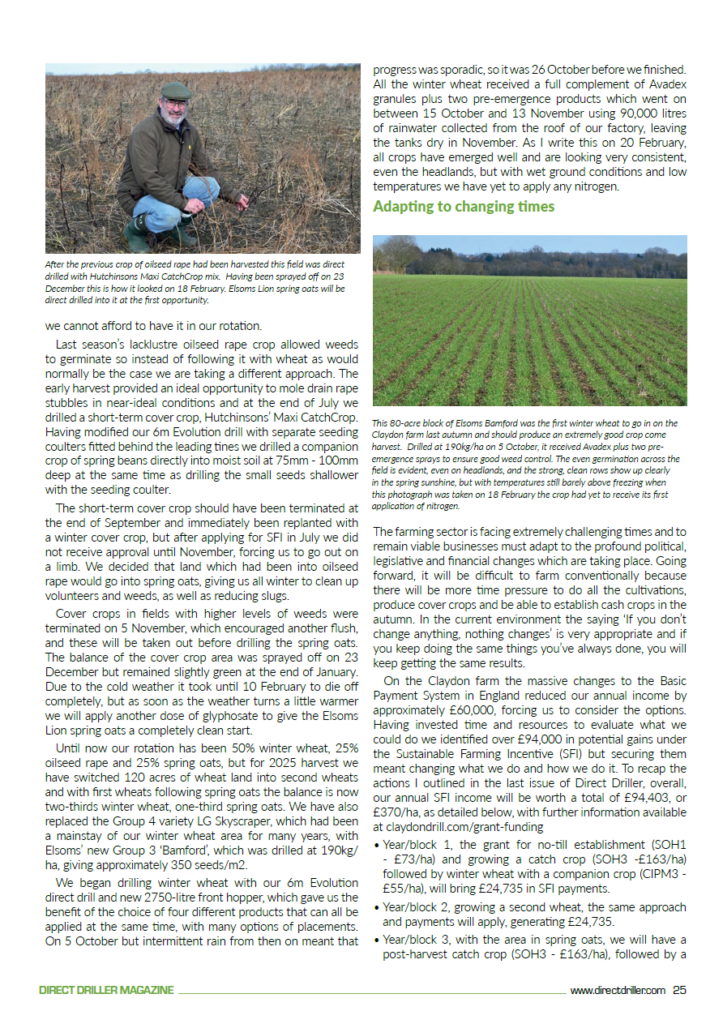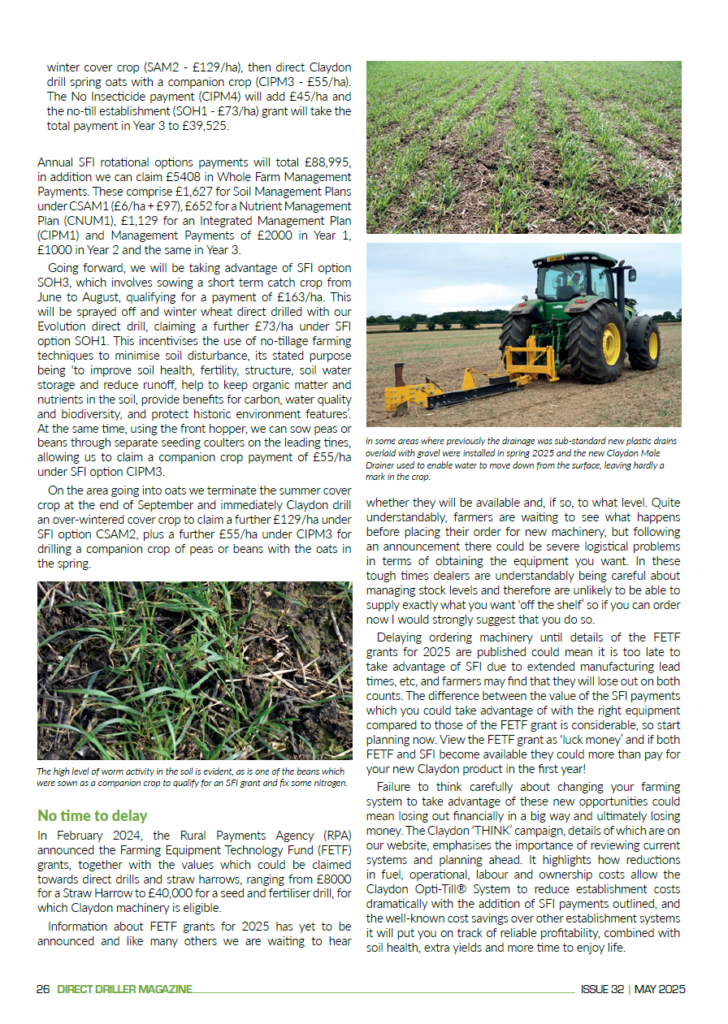The time has come to assess how you will be able to farm in the future and calculate the best options for your business going forward, says Jeff Claydon, Suffolk arable farmer and inventor of the Claydon Opti-Till® direct seeding system.
Feb 2025
Here in Suffolk, grey skies and cold weather have characterised the first few weeks of 2025, but despite little in the way of rain the soil surface has remained wet, making field work impossible. After a dry autumn and winter with few hard frosts and relatively warm temperatures, crops on our Hanslope series soils are faring exceptionally well. In no small part this is because last spring we invested £30,000 in new plastic drains to correct small areas of sub-optimal drainage highlighted by the extremely wet weather in autumn 2023.
The leading tines on our Claydon drill are enormously beneficial in allowing water to move from the surface down through the soil profile, but in a few areas the laterals were at capacity and unable to accept more water. After identifying areas where extra capacity was needed, and others where old drains had reached the end of their working life, we installed new ones. After harvest, our new Claydon Mole Drainer was used on all the oilseed rape land and in some other areas, around 200 acres in total.
The effect of this work has been transformational, and all crops are looking fantastic but there is still more to do. Some fields were too dry to mole drain in the autumn, so our goal is to go through the standing wheat this spring. Many years ago I was advised that this approach is preferable as moles formed at this time will set hard through the summer, perform better and last longer.
Some might have reservations about mole draining through a standing crop because of the potential damage, but it should not be of concern. In 1981, I went through wheat at Growth Stage 30 using our 90hp International TD18 crawler and it appeared that its steel tracks had massacred the crop. Overnight, it poured with rain and remained wet, so I was unable to finish the top part of the field. Come harvest, our recently developed Claydon Yield-o-Meter on-combine grain monitoring device highlighted the much higher yield from the mole drained area.
Last spring our Mole Drainer was used in standing winter wheat at up to GS31and come June we could barely see where it had been. Our 246hp Fendt 724 Vario has no problem pulling the new Mole Drainer, but its bigger, heavier brother, a 415hp Fendt 942 Vario will be used for this operation. It doesn’t even know it is pulling the mole drainer, even at full depth, and the tractor’s weight and wide 750-section tyres virtually eliminate wheel slip in dry conditions. Our Claydon 12m Cambridge rolls will then be used to level the field and push any stones into the ground to avoid them being picked up by the combine.

TAKING A NEW APPROACH
Our autumn-drilled crops are in excellent shape and look full of potential. There’s little difference between winter wheat drilled at the start of October, when it was very wet, and that which went in at the end of the month when it was dry. Nor is there any difference in establishment noticeable on land where wheat and spring oat straw was chopped compared with where the oat straw was baled.
Stem weevil, cabbage stem flea beetle and pigeons have long been the nemesis of oilseed rape on our farm. Last autumn, the crop established very easily but it failed to grow away strongly in the spring and closer inspection highlighted the presence of cabbage stem flea beetle larvae and stem weevil which decimated large areas, severely impacting the overall yield. The agronomic and financial risks involved in growing oilseed rape are now far too high at current values, so we cannot afford to have it in our rotation.
Last season’s lacklustre oilseed rape crop allowed weeds to germinate so instead of following it with wheat as would normally be the case we are taking a different approach. The early harvest provided an ideal opportunity to mole drain rape stubbles in near-ideal conditions and at the end of July we drilled a short-term cover crop, Hutchinsons’ Maxi CatchCrop. Having modified our 6m Evolution drill with separate seeding coulters fitted behind the leading tines we drilled a companion crop of spring beans directly into moist soil at 75mm – 100mm deep at the same time as drilling the small seeds shallower with the seeding coulter.
The short-term cover crop should have been terminated at the end of September and immediately been replanted with a winter cover crop, but after applying for SFI in July we did not receive approval until November, forcing us to go out on a limb. We decided that land which had been into oilseed rape would go into spring oats, giving us all winter to clean up volunteers and weeds, as well as reducing slugs.
Cover crops in fields with higher levels of weeds were terminated on 5 November, which encouraged another flush, and these will be taken out before drilling the spring oats. The balance of the cover crop area was sprayed off on 23 December but remained slightly green at the end of January. Due to the cold weather it took until 10 February to die off completely, but as soon as the weather turns a little warmer we will apply another dose of glyphosate to give the Elsoms Lion spring oats a completely clean start.
Until now our rotation has been 50% winter wheat, 25% oilseed rape and 25% spring oats, but for 2025 harvest we have switched 120 acres of wheat land into second wheats and with first wheats following spring oats the balance is now two-thirds winter wheat, one-third spring oats. We have also replaced the Group 4 variety LG Skyscraper, which had been a mainstay of our winter wheat area for many years, with Elsoms’ new Group 3 ‘Bamford’, which was drilled at 190kg/ha, giving approximately 350 seeds/m2.

We began drilling winter wheat with our 6m Evolution direct drill and new 2750-litre front hopper, which gave us the benefit of the choice of four different products that can all be applied at the same time, with many options of placements. On 5 October but intermittent rain from then on meant that progress was sporadic, so it was 26 October before we finished. All the winter wheat received a full complement of Avadex granules plus two pre-emergence products which went on between 15 October and 13 November using 90,000 litres of rainwater collected from the roof of our factory, leaving the tanks dry in November. As I write this on 20 February, all crops have emerged well and are looking very consistent, even the headlands, but with wet ground conditions and low temperatures we have yet to apply any nitrogen.
ADAPTING TO CHANGING TIMES
The farming sector is facing extremely challenging times and to remain viable businesses must adapt to the profound political, legislative and financial changes which are taking place. Going forward, it will be difficult to farm conventionally because there will be more time pressure to do all the cultivations, produce cover crops and be able to establish cash crops in the autumn. In the current environment the saying ‘If you don’t change anything, nothing changes’ is very appropriate and if you keep doing the same things you’ve always done, you will keep getting the same results.

On the Claydon farm the massive changes to the Basic Payment System in England reduced our annual income by approximately £60,000, forcing us to consider the options. Having invested time and resources to evaluate what we could do we identified over £94,000 in potential gains under the Sustainable Farming Incentive (SFI) but securing them meant changing what we do and how we do it. To recap the actions I outlined in the last issue of Direct Driller, overall, our annual SFI income will be worth a total of £94,403, or £370/ha, as detailed below, with further information available at claydondrill.com/grant-funding
- Year/block 1, the grant for no-till establishment (SOH1 – £73/ha) and growing a catch crop (SOH3 -£163/ha) followed by winter wheat with a companion crop (CIPM3 – £55/ha), will bring £24,735 in SFI payments.
- Year/block 2, growing a second wheat, the same approach and payments will apply, generating £24,735.
- Year/block 3, with the area in spring oats, we will have a post-harvest catch crop (SOH3 – £163/ha), followed by a winter cover crop (SAM2 – £129/ha), then direct Claydon drill spring oats with a companion crop (CIPM3 – £55/ha). The No Insecticide payment (CIPM4) will add £45/ha and the no-till establishment (SOH1 – £73/ha) grant will take the total payment in Year 3 to £39,525.

Annual SFI rotational options payments will total £88,995, in addition we can claim £5408 in Whole Farm Management Payments. These comprise £1,627 for Soil Management Plans under CSAM1 (£6/ha + £97), £652 for a Nutrient Management Plan (CNUM1), £1,129 for an Integrated Management Plan (CIPM1) and Management Payments of £2000 in Year 1, £1000 in Year 2 and the same in Year 3.
Going forward, we will be taking advantage of SFI option SOH3, which involves sowing a short term catch crop from June to August, qualifying for a payment of £163/ha. This will be sprayed off and winter wheat direct drilled with our Evolution direct drill, claiming a further £73/ha under SFI option SOH1. This incentivises the use of no-tillage farming techniques to minimise soil disturbance, its stated purpose being ‘to improve soil health, fertility, structure, soil water storage and reduce runoff, help to keep organic matter and nutrients in the soil, provide benefits for carbon, water quality and biodiversity, and protect historic environment features’. At the same time, using the front hopper, we can sow peas or beans through separate seeding coulters on the leading tines, allowing us to claim a companion crop payment of £55/ha under SFI option CIPM3.
On the area going into oats we terminate the summer cover crop at the end of September and immediately Claydon drill an over-wintered cover crop to claim a further £129/ha under SFI option CSAM2, plus a further £55/ha under CIPM3 for drilling a companion crop of peas or beans with the oats in the spring.

NO TIME TO DELAY
In February 2024, the Rural Payments Agency (RPA) announced the Farming Equipment Technology Fund (FETF) grants, together with the values which could be claimed towards direct drills and straw harrows, ranging from £8000 for a Straw Harrow to £40,000 for a seed and fertiliser drill, for which Claydon machinery is eligible.

Information about FETF grants for 2025 has yet to be announced and like many others we are waiting to hear whether they will be available and, if so, to what level. Quite understandably, farmers are waiting to see what happens before placing their order for new machinery, but following an announcement there could be severe logistical problems in terms of obtaining the equipment you want. In these tough times dealers are understandably being careful about managing stock levels and therefore are unlikely to be able to supply exactly what you want ‘off the shelf’ so if you can order now I would strongly suggest that you do so.
Delaying ordering machinery until details of the FETF grants for 2025 are published could mean it is too late to take advantage of SFI due to extended manufacturing lead times, etc, and farmers may find that they will lose out on both counts. The difference between the value of the SFI payments which you could take advantage of with the right equipment compared to those of the FETF grant is considerable, so start planning now. View the FETF grant as ‘luck money’ and if both FETF and SFI become available they could more than pay for your new Claydon product in the first year!
Failure to think carefully about changing your farming system to take advantage of these new opportunities could mean losing out financially in a big way and ultimately losing money. The Claydon ‘THINK’ campaign, details of which are on our website, emphasises the importance of reviewing current systems and planning ahead. It highlights how reductions in fuel, operational, labour and ownership costs allow the Claydon Opti-Till® System to reduce establishment costs dramatically with the addition of SFI payments outlined, and the well-known cost savings over other establishment systems it will put you on track of reliable profitability, combined with soil health, extra yields and more time to enjoy life.





